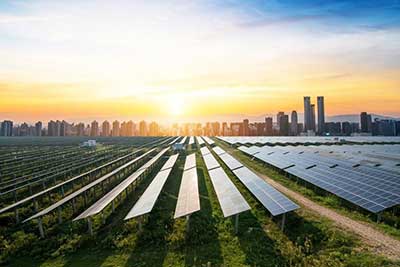Date: 18/03/2023
Relevance: GS-3: Science and Technology- developments and their applications and effects in everyday life.
Key Phrases: Renewable Energy, Decarbonization, Paris Agreement, Energy Transition, Net-Zero, Hydrogen, Carbon Emissions, Forest Cover, Transmission Infrastructure.
Context:
- India's annual carbon emissions may increase if the rush to install renewable energy capacity leads to a loss of forest cover.
Energy Transitions:
- Over the last century, energy transitions were gradual and driven by market forces, which typically do not account for negative externalities such as local pollution and carbon emissions.
- However, the current global energy transition is distinct from earlier transitions as it is policy-driven and aimed at mitigating market failures related to pollution and carbon emissions.
- Renewable energy (RE) has been the primary focus of this
policy-driven transition, with electricity serving as the main carrier.
- However, the highly decentralized nature of RE necessitates elaborate installations like solar panels and wind turbines, which require significant material and natural resource (primarily land) costs to generate usable quantities of electricity.
- This means that generating one unit of electricity from renewable energy
sources incurs substantially higher material and natural resource costs,
primarily land, compared to generating one unit of electricity from
fossil fuels.
- This increased demand for land for RE projects has not been reconciled with India's commitment to reforestation as part of its updated nationally determined contribution (NDC).
Dominant Fuel:
- In the past, energy transitions saw a significant increase in the energy released upon combustion and a decrease in carbon emissions due to the rise in hydrogen content with each step forward.
- This progression started with wood, which had hydrogen to carbon ratio (H/C) of about 0.1, then moved to coal with an H/C ratio of 1, followed by oil with a ratio of 2, and finally to natural gas, which had an H/C ratio of 4.
- The gradual increase in H/C ratio gave rise to the idea that
hydrogen was becoming the dominant fuel in the energy market, potentially
becoming the sole carrier of energy.
- However, the recent policy-driven energy transition towards renewable energy sources has somewhat disrupted this market-based transition, with electricity emerging as the primary energy carrier instead of hydrogen.
- In addition, each energy transition in the past has also led to an
increase in the gravimetric or volumetric energy density of the
dominant fuel.
- For instance, natural gas has a much lower volumetric energy density than crude oil, making it challenging to use hydrogen as a fuel for aviation due to its low volumetric energy density.
Land Requirement:
- Vaclav Smil, an influential environmental scientist, uses power density to compare various energy sources. Power density is expressed as energy flux per unit surface (water or land) in watts per square meter (W/m2).
- Smil's calculations for power density take into account the land required for upstream operations like mining and drilling, as well as the land needed for storage (especially coal) and downstream activities such as waste disposal.
- The power density of fossil fuels like crude oil, natural gas, and coal
is higher than that of renewable energy sources like solar, wind, and
biomass.
- While past energy transitions moved towards higher power densities, the current energy transition aims to shift towards fuels with much lower power densities.
- This transition would require a new infrastructure for a RE-based energy system, which would not only be much larger but also preempt other forms of land use, particularly in India, where land required for reforestation is critical.
Concerns:
- Studies show that the most solar radiation-friendly areas in India are often wasteland. However, projections indicate that only a small percentage of solar projects will be located in deserts and dry shrublands.
- Developers often avoid wasteland due to its inhospitable terrain
and lack of supporting infrastructure, which increases costs.
- However, using wasteland reduces the socio-economic and ecological costs of diverting agricultural land for renewable energy (RE) projects.
- The land required for India to achieve the 175 GW RE goals is
estimated to be 1-3% of the total surface area, but almost 50-100% of
wasteland.
- A study estimates that if solar PV accounts for 78% of electricity generation in India by 2050, and 3% are from rooftop solar PV, the land area required could be up to 2% of crop area.
- This could lead to clearing unmanaged forests, which goes against India's NDC pledge to create an additional carbon sink through new forest and tree cover by 2030.
Conclusion:
- The 2022 land gap report states that fulfilling India's pledge for reforestation would necessitate using 56 percent of the country's land area, which is a magnitude higher than what larger countries like the USA (14 percent) and China (2 percent) require for similar forest cover pledges.
- Other estimates propose that 30-40 million hectares (M ha) of land, equivalent to the combined area of Bihar, Jharkhand, and West Bengal, would be necessary for reforestation.
- The reforestation pledge in India has not been well integrated
with the country's renewable energy (RE) installation targets, creating a
competition for land that may benefit RE installations supported by powerful
economic interests.
- However, rushing to install RE capacity could lead to the loss of forest cover that could potentially offset most of India's annual carbon emissions of 3 BT.
Source: Observer Research Foundation
Mains Question:
Q. What steps should India take to balance its renewable energy installation targets with its reforestation pledge and minimize the impact on forest cover and carbon emissions? (150 words).







